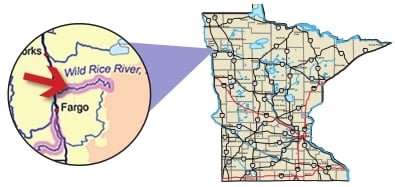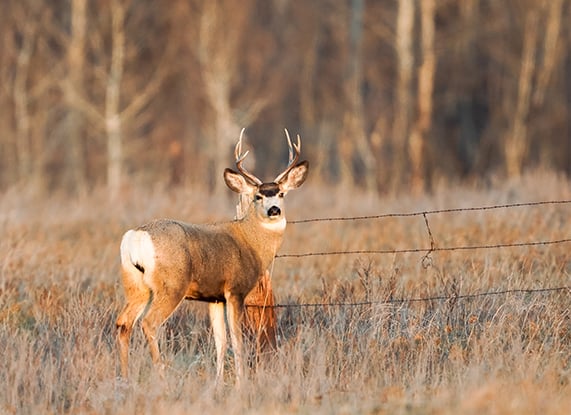Erosion control aids Wild Rice River water quality in Minnesota – Outdoor News
Callaway, Minn. — The Becker Soil and Water Conservation District has worked with landowners to install more than 660 water- and sediment-control basins during the past 20 years. The projects were slow to catch on at first, but interest in the basins surged as farmers saw how well they mended gullies and curbed erosion.
“It’s a night-and-day difference. It went from a washout that was 6 feet deep to (now) we farm across it and there’s absolutely no problem with it as far as erosion whatsoever,” Riceville Township farmer Tom Bergren said of a multi-basin project spanning his field and a neighbor’s field upstream.
The SWCD has a list of about 80 water- and sediment-control basins ready to be installed once technical assistance and contractors are available.
The Legacy Amendment’s Clean Water Fund helped to meet that demand on land that drains to the South Branch Wild Rice River, one of the major contributors of sediment to the Red River. Curbing sediment and the phosphorus it carries has a positive effect from here to Lake Winnipeg, where blue-green algal blooms – increasingly frequent during the past 30 years – have at times covered more than 50% of the lake’s surface.
MORE COVERAGE FROM OUTDOOR NEWS:
Minnesota DNR takes a cautious approach to 2024 deer hunting
The Minnesota Board of Water and Soil Resources awarded the SWCD two competitive Clean Water Fund grants centered on sediment reduction in the South Branch Wild Rice River: $257,000 in 2015 and $470,430 in 2020. The two-phase project resulted in work with 16 landowners to install 60 water- and sediment-control basins, eight filter strips on 28.5 acres, one grade stabilization, and one grassed waterway. Estimates showed work backed by the two grants would reduce suspended solids in the river by nearly 40%.
 The Clean Water Fund support is continuing through Watershed-Based Implementation Funding. More than half of the $1.37 million BWSR made available to the Wild Rice-Marsh River partnership in 2023 – $816,252 – is earmarked for projects and practices targeting high-priority catchments (areas where water collects when it rains).
The Clean Water Fund support is continuing through Watershed-Based Implementation Funding. More than half of the $1.37 million BWSR made available to the Wild Rice-Marsh River partnership in 2023 – $816,252 – is earmarked for projects and practices targeting high-priority catchments (areas where water collects when it rains).
In 2023, WBIF-backed work centered on the South Branch Wild Rice River involved one landowner with five water- and sediment-control basins, one landowner who planted 136 acres of cover crops, and a soil health field day that drew 60 people.
The Wild Rice Watershed District is the fiscal agent for the WBIF grant, which funds priorities identified in the Wild Rice-Marsh comprehensive watershed management plan developed under BWSR’s One Watershed, One Plan. The 14 plan partners include Becker, Clay, Clearwater, Mahnomen, and Norman counties and SWCDs, Polk County, East Polk and West Polk SWCDs, and the WRWD.
Leveraging Clean Water Funds with Environmental Quality Incentives Program assistance from the USDA’s Natural Resources Conservation Service can cut landowners’ share to 10%.
The WRWD’s contribution toward the water- and sediment-control basin projects – $25,000 in 2014 and another $25,000 in 2022 – came from taxes levied for projects that benefit the district as a whole.
“It meets the overall goals that the board of managers works toward in reducing flooding and reducing erosion throughout the district,” said WRWD Administrator Tara Jensen. “It’s maybe a smaller footprint, but when you have several (projects), like Becker County has, it makes a larger impact.”
A simple, one-basin project can cost $3,000. Larger, multi-landowner projects can exceed $150,000.
“Would they do it on their own? That’s a lot of money,” said Becker SWCD Administrator Bryan Malone. “The goal is to use both Clean Water Funds and federal funds to get these projects done and help the landowners reduce their expenses.”
To receive the full 90% assistance, landowners must implement additional best management practices such as installing filter strips or fencing a livestock exclusion.
“I’m pretty confident they wouldn’t be doing the projects we’re doing the way we’re doing them,” Ed Clem, Becker SWCD soil and water resource technician, said of conservation practices resulting from that added incentive. “There’s a benefit to the landowners for not only the erosion control – farmers are interested in saving sediment – but the drainage benefit is probably the largest seller for a lot of these guys.”
Over the years, Bergren has worked with the SWCD and NRCS staff to install water- and sediment-control basins in 10 fields – projects he said would have been impossible without the funding. One of those fields alone contains 13 structures that mended a 15-foot-wide, 15-foot-deep gully.
“You could drive a semi-truck into it and you wouldn’t see it,” Bergren said.
On another piece of land where washouts divided a field into four segments, Bergren said installing water- and sediment-control basins made it possible to farm the length of the field – improving efficiency while curbing nutrient loss by slowing and filtering the water.
“The public is getting the benefit of no longer having that active gully eroding into the river,” Clem said of projects throughout the county, noting that erosion-control measures reduce how much sediment and phosphorus is carried into the river. “There’s a huge benefit to the public with water- and sediment-control basins. … It’s a big win-win for farmers. They’re not doing it only for conservation; they’re doing it also for economics.”
Because the simpler projects were installed first, NRCS District Conservationist Ed Musielewicz anticipated seeing fewer but more expensive projects in years ahead.
“I think that’s where we’re headed going forward, is to do some more of those complex projects,” Musielewicz said.
Becker County’s first five water- and sediment-control basins were installed in 1996. In 2023, the SWCD installed 95 water- and sediment-control basins. Nine more contracts involved 37 construction-ready basins for which plans were finished – those were either awaiting funding or slated for 2023 completion. The waiting list included 15 potential contracts to install 81 water- and sediment-control basins in 2024.





